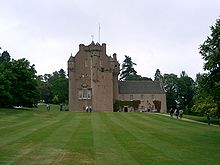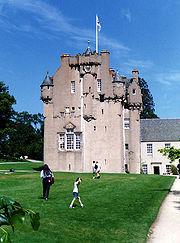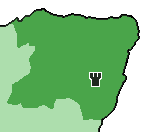
Crathes Castle
Encyclopedia
Crathes Castle is a 16th century castle
near Banchory
in the Aberdeenshire
region of Scotland
. This harled
castle was built by the Burnetts of Leys and was held in that family for almost 400 years. The castle and grounds are presently owned and managed by the National Trust for Scotland
and are open to the public.
In the 14th and 15th century the Burnett of Leys built a fortress of timbers on an island they made in the middle of a nearby bog. This method of fortification, known as a crannog
, was common in the Late Middle Ages
. Construction of the current tower house of Crathes Castle was begun in 1553 but delayed several times during its construction due to political problems during the reign of Mary, Queen of Scots.
 It was completed in 1596 by Alexander Burnett of Leys
It was completed in 1596 by Alexander Burnett of Leys
, and an additional wing added in 18th century. Alexander Burnett, who completed the construction of Crathes, began a new project, the early 17th century reconstruction of nearby Muchalls Castle
. That endeavour was completed by his son, Sir Thomas Burnett
. Crathes Castle served as the ancestral seat of the Burnetts of Leys
until gifted to the National Trust for Scotland by the 13th Baronet of Leys, Sir James Burnett in 1951. A fire damaged portions of the castle (in particular the Queen Anne
wing) in 1966. Another historically important structure in this region linked to the Burnett of Leys family is Monboddo House
.
survive in several Jacobean
rooms: the Chamber of the Muses, the Chamber of Nine Worthies and the Green Lady's Room. The last of these is said to be haunted by a green lady. A green smoke or mist is said to have been seen by visitors. The ancient jewelled ivory Horn of Leys residing in the great hall above the fireplace, was gifted to the Burnetts by the king along with the castle grounds in 1323
. Within the walled garden are gravel paths with surrounding specimen plants mostly in herbaceous borders. Many of the plants are labelled with taxonomic descriptions. There is also a grass croquet court at a higher terraced level within the walled garden. Ancient topiary
hedges of Irish yew dating from 1702 separate the gardens into eight themed areas. Crathes and its grounds are open to tourists throughout the year. A visitors centre provides information about the castle and its surroundings. There is a tea shop on site and a car park.


Castle
A castle is a type of fortified structure built in Europe and the Middle East during the Middle Ages by European nobility. Scholars debate the scope of the word castle, but usually consider it to be the private fortified residence of a lord or noble...
near Banchory
Banchory
Banchory is a burgh or town in Aberdeenshire, Scotland, lying approximately 18 miles west of Aberdeen, near where the Feugh River meets the River Dee.- Overview :...
in the Aberdeenshire
Aberdeenshire
Aberdeenshire is one of the 32 unitary council areas in Scotland and a lieutenancy area.The present day Aberdeenshire council area does not include the City of Aberdeen, now a separate council area, from which its name derives. Together, the modern council area and the city formed historic...
region of Scotland
Scotland
Scotland is a country that is part of the United Kingdom. Occupying the northern third of the island of Great Britain, it shares a border with England to the south and is bounded by the North Sea to the east, the Atlantic Ocean to the north and west, and the North Channel and Irish Sea to the...
. This harled
Harling
Harling can refer to:* Harl, a building technique* East Harling, a village in Norfolk, England* Harling, Norfolk, the parish of which East Harling is the principal settlement* Harling Road railway station, station servicing East Harling...
castle was built by the Burnetts of Leys and was held in that family for almost 400 years. The castle and grounds are presently owned and managed by the National Trust for Scotland
National Trust for Scotland
The National Trust for Scotland for Places of Historic Interest or Natural Beauty, commonly known as the National Trust for Scotland describes itself as the conservation charity that protects and promotes Scotland's natural and cultural heritage for present and future generations to...
and are open to the public.
History
Crathes sits on land given as a gift to the Burnett of Leys family by King Robert the Bruce in 1323.In the 14th and 15th century the Burnett of Leys built a fortress of timbers on an island they made in the middle of a nearby bog. This method of fortification, known as a crannog
Crannog
A crannog is typically a partially or entirely artificial island, usually built in lakes, rivers and estuarine waters of Scotland and Ireland. Crannogs were used as dwellings over five millennia from the European Neolithic Period, to as late as the 17th/early 18th century although in Scotland,...
, was common in the Late Middle Ages
Late Middle Ages
The Late Middle Ages was the period of European history generally comprising the 14th to the 16th century . The Late Middle Ages followed the High Middle Ages and preceded the onset of the early modern era ....
. Construction of the current tower house of Crathes Castle was begun in 1553 but delayed several times during its construction due to political problems during the reign of Mary, Queen of Scots.

Alexander Burnett of Leys (d. 1619)
Alexander Burnett of Leys was the Laird of Crathes Castle in the late 16th and early 17th century, being credited for the completion of Crathes in 1596 He acquired Muchalls Castle circa 1600 and commenced its early 17th century reconstruction...
, and an additional wing added in 18th century. Alexander Burnett, who completed the construction of Crathes, began a new project, the early 17th century reconstruction of nearby Muchalls Castle
Muchalls Castle
Muchalls Castle stands overlooking the North Sea in the countryside of Kincardine and Mearns, Aberdeenshire, Scotland. The lower course is a well preserved double groined 13th century towerhouse structure, built by the Frasers of Muchalls. Upon this structure, the 17th century castle was begun by...
. That endeavour was completed by his son, Sir Thomas Burnett
Thomas Burnett
Thomas Burnett may refer to:*Thomas Burnet , theologian*Sir Thomas Burnett, 1st Baronet *Sir Thomas Burnett, 3rd Baronet , MP for Scotland 1707–1708*Sir Thomas Burnett, 6th Baronet...
. Crathes Castle served as the ancestral seat of the Burnetts of Leys
Burnetts of Leys
Clan Burnett is a Lowland Scottish clan from Deeside, near Banchory in Northeast Scotland. From the early 14th century to the mid 16th century the family occupied a lake dwelling on the Loch of Leys, and resided here or on land near the lake for over 200 years...
until gifted to the National Trust for Scotland by the 13th Baronet of Leys, Sir James Burnett in 1951. A fire damaged portions of the castle (in particular the Queen Anne
Anne of Great Britain
Anne ascended the thrones of England, Scotland and Ireland on 8 March 1702. On 1 May 1707, under the Act of Union, two of her realms, England and Scotland, were united as a single sovereign state, the Kingdom of Great Britain.Anne's Catholic father, James II and VII, was deposed during the...
wing) in 1966. Another historically important structure in this region linked to the Burnett of Leys family is Monboddo House
Monboddo House
Monboddo House is a historically famous mansion in The Mearns, Scotland. The structure was generally associated with the Burnett of Leys family. The property itself was owned by the Barclay family from the 13th century, at which time a tower house structure was erected...
.
Interior
The castle contains a significant collection of portraits, and intriguing original Scottish renaissance painted ceilingsScottish Renaissance painted ceilings
A number of Scottish houses and castles built between 1540 and 1640 have painted ceilings. This is a distinctive national style, though there is common ground with similar work elsewhere, especially in France, Spain and Scandinavia. Most surviving examples are painted simply on the boards and...
survive in several Jacobean
Jacobean architecture
The Jacobean style is the second phase of Renaissance architecture in England, following the Elizabethan style. It is named after King James I of England, with whose reign it is associated.-Characteristics:...
rooms: the Chamber of the Muses, the Chamber of Nine Worthies and the Green Lady's Room. The last of these is said to be haunted by a green lady. A green smoke or mist is said to have been seen by visitors. The ancient jewelled ivory Horn of Leys residing in the great hall above the fireplace, was gifted to the Burnetts by the king along with the castle grounds in 1323
Garden and grounds
The castle estate contains 530 acres (2.1 km²) of woodlands and fields, including nearly four acres (16,000 m²) of walled gardenWalled garden
A walled garden is specifically a garden enclosed by high walls for horticultural rather than security purposes, though traditionally all gardens have been hedged about or walled for protection from animal or human intruders...
. Within the walled garden are gravel paths with surrounding specimen plants mostly in herbaceous borders. Many of the plants are labelled with taxonomic descriptions. There is also a grass croquet court at a higher terraced level within the walled garden. Ancient topiary
Topiary
Topiary is the horticultural practice of training live perennial plants, by clipping the foliage and twigs of trees, shrubs and subshrubs to develop and maintain clearly defined shapes, perhaps geometric or fanciful; and the term also refers to plants which have been shaped in this way. It can be...
hedges of Irish yew dating from 1702 separate the gardens into eight themed areas. Crathes and its grounds are open to tourists throughout the year. A visitors centre provides information about the castle and its surroundings. There is a tea shop on site and a car park.


External links
- Crathes Castle - official site at National Trust for ScotlandNational Trust for ScotlandThe National Trust for Scotland for Places of Historic Interest or Natural Beauty, commonly known as the National Trust for Scotland describes itself as the conservation charity that protects and promotes Scotland's natural and cultural heritage for present and future generations to...
- Crathes Website
- Official Burnett Website
- Banchory Community Website
- Visit Banchory Website
- about aberdeen
- Ghost stories of Crathes Castle

